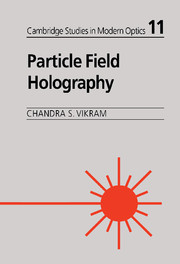Book contents
- Frontmatter
- Contents
- Foreword
- Preface
- Acknowledgements
- 1 Historical background
- 2 Introduction to holography
- 3 General theory of in-line Fraunhofer holography
- 4 System design considerations
- 5 Practical considerations
- 6 Analysis of reconstruction
- 7 Aberrations and their control
- 8 Hologram fringe-contrast and its enhancement
- 9 Non-image plane analysis
- 10 Velocimetry and high speed holography
- 11 The off-axis approach
- References
- Index
9 - Non-image plane analysis
Published online by Cambridge University Press: 13 October 2009
- Frontmatter
- Contents
- Foreword
- Preface
- Acknowledgements
- 1 Historical background
- 2 Introduction to holography
- 3 General theory of in-line Fraunhofer holography
- 4 System design considerations
- 5 Practical considerations
- 6 Analysis of reconstruction
- 7 Aberrations and their control
- 8 Hologram fringe-contrast and its enhancement
- 9 Non-image plane analysis
- 10 Velocimetry and high speed holography
- 11 The off-axis approach
- References
- Index
Summary
The general procedure of the analysis is to bring the reconstructed image in focus at the final observation plane. This mode of analysis is very common. However, particularly in the in-line method, there are proposals to perform the analysis at other planes. These are: the recording plane (hologram) itself, the misfocused image plane, and certain transform (Fourier) planes. These approaches have advantages in particular situations. In this chapter, these techniques of non-image plane analysis are discussed. Non-image plane analysis techniques have applications in velocimetry also. Those methods are dicussed in Chapter 10.
Analysis of the far-field pattern
The pattern at the recording plane of the Fraunhofer hologram itself contains information about the object and its location. The possibility of extracting the desired information from the pattern is as old as Fraunhofer holography itself. Thompson and coworkers proposed utilizing the pattern itself for the analysis at the early stages of the development of far-field holography. There are two approaches. One is to study the entire complex pattern to determine the size and the distance of the microobject. This is called the coherent background method due to the presence of the reference beam. The other method, called the spatial filtering method, yields the broad diffraction pattern for further analysis.
Coherent background method
The principle of the technique can be described from a typical Fraunhofer diffraction pattern. The schematic diagram is shown in Figure 9.1.
- Type
- Chapter
- Information
- Particle Field Holography , pp. 187 - 208Publisher: Cambridge University PressPrint publication year: 1992



